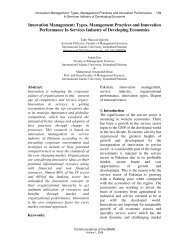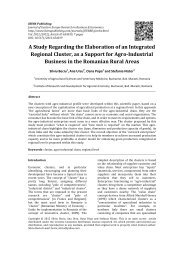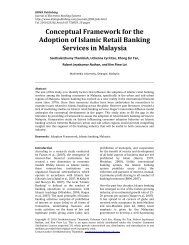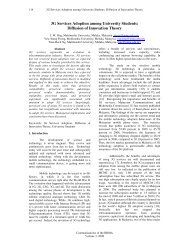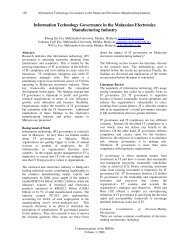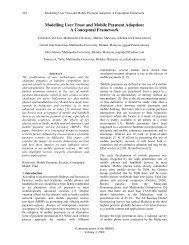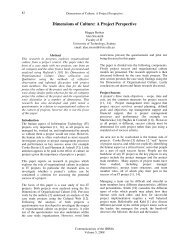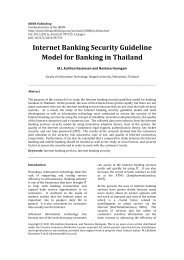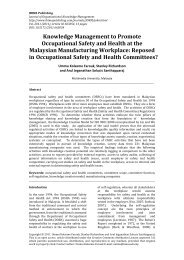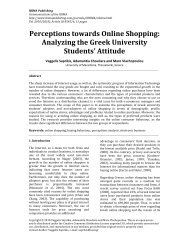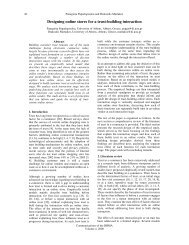Mobile Phone version - IBIMA Publishing
Mobile Phone version - IBIMA Publishing
Mobile Phone version - IBIMA Publishing
Create successful ePaper yourself
Turn your PDF publications into a flip-book with our unique Google optimized e-Paper software.
<strong>IBIMA</strong> Business Review<br />
Vol. 2011 (2011), Article ID<br />
890061, 341 minipages.<br />
DOI:10.5171/2011.890061<br />
www.ibimapublishing.com
Copyright © 2011 Asli Deniz<br />
Helvacioglu Kuyucu. This is an open<br />
access article distributed under the<br />
Creative Commons Attribution License<br />
unported 3.0, which permits<br />
unrestricted use, distribution, and<br />
reproduction in any medium, provided<br />
that original work is properly cited.
Exploring Policy-<br />
Formulation for SMEs in<br />
Cloud Computing:<br />
The Case of Turkey
Author<br />
Asli Deniz Helvacioglu<br />
Kuyucu<br />
Department of International<br />
Trade, Bogazici University,<br />
Istanbul, Turkey
Abstract<br />
The promise of<br />
competitiveness that clouds<br />
offer to enterprises creates<br />
a substantial part of the
cloud phenomenon. 2010<br />
European Union report on<br />
cloud computing identifies<br />
the strong commercial<br />
nature of clouds and<br />
addresses new policies and
actions for the<br />
competitiveness of<br />
European industry. Today,<br />
European Union attributes<br />
competitiveness to the<br />
smart growth of SMEs. The
concept of smart growth is<br />
based on effective policies<br />
that foster innovation and<br />
capability to adopt the<br />
dynamics of information<br />
society. This paper aims at
exploring the policymaking<br />
methods for cloud<br />
computing that will serve<br />
to enhance the<br />
competitiveness of SMEs. It<br />
analyses the dynamics of
Turkish policy-making and<br />
discusses the role of EU<br />
policies in a candidate<br />
country as the motivators<br />
of migration to clouds. It is<br />
an output of an ongoing
esearch on cloud<br />
computing in Turkey. This<br />
paper contributes to the<br />
literature as being one of<br />
the first studies on policymaking<br />
for cloud
computing. It provides a<br />
twofold policy tool<br />
proposed for policymakers.<br />
First, it identifies<br />
the dynamics of policymaking<br />
by adapting the
model of Van Schendelen’s<br />
general categories of<br />
decision buttons for EU<br />
lobbying to the Turkish<br />
policy-making mechanisms.<br />
Secondly, it detects the
main patterns of cloud<br />
computing policy under<br />
five priority areas as a<br />
check list for policymakers.
Keywords: Cloud<br />
Computing, European<br />
Union, Policy-Making,<br />
Turkey
Introduction<br />
Cloud computing has<br />
turned out to be one of the<br />
hottest topics. It offers a<br />
wide area of research, most
of which is still unexplored.<br />
This is also reflected to the<br />
variety of definitions<br />
(Vaquero et al., 2009).<br />
There are many different<br />
definitions for clouds.
National Institute of<br />
Standards and Technology,<br />
Information Technology<br />
Laboratory (NIST, 2010)<br />
defines cloud computing as<br />
“a model for enabling
convenient, on-demand<br />
network access to a shared<br />
pool of configurable<br />
computing resources (e.g.,<br />
networks, servers, storage,<br />
applications, and services)
that can be rapidly<br />
provisioned and released<br />
with minimal management<br />
effort or service provider<br />
interaction.” European<br />
Community for Software
and Software Services<br />
(ECSS, 2010) describes<br />
cloud computing as “the<br />
delivery of computational<br />
resources from a location<br />
other than your current
one”. Accordingly, it is a<br />
style of computing in which<br />
IT-related capabilities are<br />
provided “as a service”<br />
allowing users to access<br />
technology-enabled
services from the Internet<br />
without knowledge of,<br />
expertise with, or control<br />
over the technology<br />
infrastructure that<br />
supports them. The
definition that the<br />
European Union (EU)<br />
publications refer to, bears<br />
a broader perspective and<br />
explains the cloud as an<br />
elastic execution
environment of resources<br />
involving multiple<br />
stakeholders and providing<br />
a metered service at<br />
multiple granularities for a<br />
specified level of quality (of
service) (Jeffery and<br />
Neidecker-Lutz, 2010).<br />
All definitions, in the end,<br />
highlight that clouds are<br />
dynamic, flexible,
customizable and costbased<br />
efficient. These<br />
aspects make the cloud<br />
phenomenon grow more<br />
and more each day. IDC<br />
predicts that in 2013,
worldwide cloud services<br />
will reach to $44.2bn with a<br />
European market of<br />
€6,005m (Gorniak, 2009).<br />
This signifies that<br />
migration to cloud
computing becomes a<br />
strategic choice of<br />
competitive advantage for<br />
companies. IDC’s 2009<br />
report “Cloud-based<br />
application development
and test services:<br />
customers leading<br />
requirements and provider<br />
preferences” held among<br />
400 IT and line of business<br />
executives in the US and
Europe, concludes that<br />
larger enterprises are going<br />
down the cloud route in<br />
drives, in search of greater<br />
cost efficiencies and faster<br />
times to market for
application development<br />
and testing services<br />
(Stinchcombe, 2009). The<br />
results from 2010 CIO<br />
survey on business<br />
priorities and strategies
(Gartner Executive<br />
Programs, 2010) show that<br />
CIOs rank cloud computing<br />
second among top ten<br />
technology priorities,<br />
addressing it as a
collaborative and<br />
productive solution to<br />
accelerate information<br />
technology (IT) transition<br />
from a support function to<br />
strategic contributor
focused on innovation and<br />
competitive advantage.<br />
Accordingly, 71% of<br />
companies believe that<br />
cloud computing is a real<br />
technology option whereas,
70% hold that it would<br />
make their business flexible<br />
and 62% think that it<br />
would help them react<br />
quickly to market
conditions (Misra and<br />
Mondal, 2010).<br />
As big corporate companies<br />
hype the clouds, there is<br />
also a tendency among
small and medium-sized<br />
enterprises (SMEs). Etro<br />
(2009) claims that diffusion<br />
of cloud computing could<br />
provide a positive and<br />
substantial contribution to
the annual growth rate (up<br />
to a few decimal points),<br />
helping to create about a<br />
million new jobs through<br />
the development of a few<br />
hundred thousand new
SMEs in the European<br />
Union (EU). SMEs believe<br />
that clouds enable fast<br />
access to best business<br />
applications or drastically<br />
boost infrastructure
esources, all at negligible<br />
cost (Subashini and<br />
Kavitha, 2010). Cloud<br />
computing technologies<br />
enable SMEs to develop<br />
cost effective business
models where they only<br />
have to pay only for the<br />
operating cost as capital<br />
investment, security,<br />
backup and server<br />
maintenance costs rest all
among the provider’s<br />
responsibilities (Sharma et<br />
al., 2010). Studies focusing<br />
on SME perspectives for<br />
cloud computing highlight<br />
that SMEs show positive
attitudes towards the<br />
market need for cloud<br />
computing (Redmond et al.,<br />
2010)
The assumptions for the<br />
boost of cloud computing<br />
are clearly thrilling at these<br />
times when the world<br />
economy is facing some<br />
real challenges and there is
a certain need for an<br />
economic recovery. Sultan<br />
(2010) claims that cloud<br />
computing is likely to be<br />
proved commercially viable<br />
for many small and medium
enterprises (SMEs) due to<br />
its flexibility and pay-asyou-go<br />
cost structure,<br />
particularly in the current<br />
climate of economic<br />
difficulties. Cloud providers
appreciate the system as it<br />
is a functional solution to<br />
SMEs’ high-cost technology<br />
investments. Clouds enable<br />
reduction of cost and effort<br />
through outsourcing and
automation of essential<br />
resource management<br />
(Jeffery and Neidecker-<br />
Lutz, 2010). In this regard,<br />
policies that stimulate SME<br />
competitiveness would
have an important role in<br />
structuring cloud<br />
computing within the<br />
economy. Cloud computing<br />
policies shall therefore, be<br />
an important complement
for SMEs not only, to<br />
enhance competitiveness in<br />
this new, revolutionary era<br />
but also to attain<br />
sustainable, efficient<br />
economic development.
Migration to cloud can be a<br />
source for competitiveness<br />
if the SMEs are ready to<br />
adopt a cloud-oriented way<br />
of organizing and accessing<br />
the technological
infrastructure. So the<br />
policies that are designed<br />
for clouds should work for<br />
stimulating a migration<br />
path which is based on<br />
agility and innovation.
The most challenging part<br />
of SME policies lies in the<br />
fact that the major<br />
expectancy of SMEs from<br />
policy-makers is to achieve<br />
better access to finance.
The competitiveness of<br />
SMEs is very much related<br />
with their flexible structure<br />
that helps them to be more<br />
rapid taking the essential<br />
management decisions as
well as being able to modify<br />
their production in<br />
accordance with the<br />
changes in the market. At<br />
the very same time, SMEs<br />
face financial constraints
and they depend upon the<br />
sustainability of the<br />
revenues. Therefore cost of<br />
anything is important for<br />
SMEs. Parallel to this need,<br />
clouds are marketed with
their cost-saving feature<br />
which is quite<br />
revolutionary. Clouds offer<br />
a new way of business<br />
which aims at optimizing<br />
cost in positive ways.
However, clouds cannot be<br />
a right track of cost-saving<br />
as long as the SMEs do not<br />
know how to use it. Plus, it<br />
may open up a new cost<br />
frame which is the
oadband connection.<br />
Therefore, policy-making<br />
for clouds should be an<br />
interdisciplinary work that<br />
includes competitiveness,
finance, technology and<br />
law.<br />
This paper aims at<br />
exploring the potential of<br />
cloud computing policies
for the competitiveness of<br />
SMEs by analyzing the<br />
patterns of Turkish SME<br />
policy. A special emphasis<br />
is given to the EU policies<br />
as Turkey’s candidate
status brings forward<br />
harmonization with EU.<br />
The paper discusses SME<br />
policies in Turkey by<br />
referring to the EU<br />
approach which provides a
asis for policy-making for<br />
cloud computing as a part<br />
of Turkey’s candidate<br />
status. It is one of the first<br />
outputs of an ongoing<br />
research on cloud
computing in Turkey and<br />
contributes to the literature<br />
as one of the first studies on<br />
this issue.
The first part of the paper<br />
focuses on the dynamics of<br />
policy-making in EU<br />
harmonization process and<br />
identifies the major points<br />
of SME policies in Turkey
and EU, whereas the second<br />
part provides a twofold<br />
policy tool proposed for<br />
policy-makers in Turkey.<br />
The paper highlights policyformulation<br />
in Turkey by
adapting the model of Van<br />
Schendelen’s general<br />
categories of decision<br />
buttons for EU lobbying to<br />
the Turkish policy-making<br />
mechanisms. This modeling
is a novel contribution to<br />
the literature as it uses<br />
European mechanism for<br />
domestic policy-making<br />
system for the first time.<br />
Lastly, the paper detects
the main patterns of a<br />
possible cloud computing<br />
policy for Turkey under five<br />
priority areas. Those<br />
patterns are provided as a<br />
checklist for policy-makers.
Policy-Learning in the<br />
Light of the EU Exposure<br />
Turkey’s candidate status<br />
provides a basis for many<br />
policy areas that are subject
to EU accession<br />
negotiations. EU<br />
harmonization process is<br />
mainly the process of<br />
adoption and adaptation of<br />
what EU offers in terms of
legal, economic and policyoriented<br />
outputs, in<br />
accordance with the<br />
dynamics of the candidate<br />
country. In some policy<br />
areas, like agriculture and
environment, this process<br />
may turn into a very<br />
complex issue as there are<br />
conflicts between the<br />
national and Community<br />
interest. However, in new
and emerging policy areas,<br />
the guidance of EU may<br />
lead to new opportunities<br />
for the candidate country.<br />
Best practices of the EU<br />
experience may assist the
candidate country to adopt<br />
more efficient and effective<br />
policies.<br />
The theme of information<br />
society corresponds to the
themes of the era of<br />
globalization and<br />
constitutes main point of<br />
global policy efforts (Drori,<br />
2007). The tendency to<br />
favor the search for a
universal model of the<br />
information society<br />
remains very strong<br />
especially within the<br />
institutions of policymaking<br />
(Mansell, 2009). As
seen in innovation policy, in<br />
new, technology-focused<br />
policy areas, policy makers<br />
need sufficient<br />
competences and expertise<br />
for the identification of
problems, in order to find<br />
appropriate solutions and<br />
instruments for the<br />
implementation of policy<br />
measures (Koschatzky,<br />
2009). However, in
developing countries, there<br />
is a sense of urgency in<br />
policy-making for the<br />
issues covered by the<br />
information society agenda<br />
which is a result of a
perceived need to ‘catch up’<br />
with the rest of the world<br />
(Duncan-Howell et al.,<br />
2008). The lack of<br />
consistency between policy<br />
design and the actions
proposed to achieve the<br />
objectives of the policy may<br />
result in an unsustainable<br />
environment where the<br />
actors loose competitive<br />
advantage dramatically
(Castro-Martinez et al.,<br />
2009, Duncan-Howell et al.,<br />
2008, Mollas-Gallart and<br />
Davies, 2006). EU, acting as<br />
a role model, may advance<br />
policy-learning process
(Koschatzky, 2009) and<br />
also create a benchmark for<br />
the creation of favorable<br />
conditions. However, it<br />
should be mentioned that a<br />
complete copy-paste
approach to policy-making<br />
which is based on adoption<br />
of best practices can only<br />
represent a standard<br />
endowment but not a<br />
guarantee for an easy win
(Piccaluga, 2009). The<br />
effectiveness and efficiency<br />
of the proposed policy<br />
derives from the ability of<br />
the candidate country to<br />
use the EU practices and
policy priorities as the basis<br />
to adopt differentiated<br />
national policies that are<br />
also internationally<br />
compatible. Accordingly,<br />
country specific features
and policy priorities depict<br />
systems where policy<br />
responses are more<br />
effective in achieving<br />
national goals (Guinet,<br />
2010). Information and
communication technology<br />
policies are better to be<br />
comprehensive and created<br />
in line with local norms,<br />
values, and culture in order<br />
to meet the socio-economic
needs and objectives like<br />
poverty reduction, and<br />
improvement of quality of<br />
life (Kendall et al., 2006).
SME Policies in EU and<br />
Turkey under the Scope of<br />
Information Society<br />
In EU, over 99% of EU<br />
enterprises are SMEs and
they provide over two<br />
thirds of private sector<br />
jobs, including 80% of new<br />
jobs created in EU over the<br />
last five years (European<br />
Commission, 2009). This
can be seen as a quasi<br />
requirement for EU to<br />
adopt articulated and<br />
ambitious policies for<br />
SMEs. Europe 2020<br />
(European Commission,
2010), recently introduced<br />
European strategy for<br />
smart, sustainable and<br />
inclusive growth, presents<br />
the dawn of a new SME<br />
policy which is mostly
supported by information<br />
and communications<br />
technology (ICT) schemes.<br />
This strategy reframes the<br />
SME policy of EU to support<br />
the development of a
strong and sustainable<br />
industrial base that will<br />
help EU to compete<br />
globally. It covers better<br />
conditions for business to<br />
innovate and more
functional EU instruments<br />
to support innovation,<br />
especially in the field of<br />
ICTs. EU wants to reinforce<br />
Europe's technology<br />
strength in key strategic
fields in order to stimulate<br />
ICT innovation across all<br />
business sectors. As stated<br />
in the Lisbon Agenda, EU<br />
continues to work for to<br />
achieve the most
competitive knowledgebased<br />
economy in the<br />
world.<br />
SME policy remains to be<br />
one of the policy areas
where Turkey has aligned<br />
herself with EU. Parallel to<br />
the EU objectives, the 9th<br />
Development Plan of<br />
Turkey (2007-2013) which<br />
is prepared with the vision
of being a country of<br />
information society, states<br />
that Turkey should work to<br />
achieve global<br />
competitiveness and aim at<br />
fully completing her
integration with European<br />
Union. This Development<br />
Plan sets the vision for<br />
SMEs under the<br />
competitiveness title and<br />
identifies SME policies
within three main<br />
objectives; access to<br />
finance, efficient support<br />
schemes and innovation<br />
and modernization as an
integrated part of<br />
information society.<br />
The basis for SME policies<br />
in Turkey is the SME<br />
Strategy and Action Plan
(Planning Organization,<br />
2004) which is prepared in<br />
the light of the European<br />
Charter for Small<br />
Enterprises. It is a<br />
document bringing the
European approach to<br />
SMEs in Turkey. In 2005,<br />
Turkey adopted the new<br />
SME definition which is<br />
also totally in line with the<br />
EU approach. An updated
SME Strategy and Action<br />
Plan (2007-2009) are<br />
adopted, after the<br />
publication of the 2006<br />
Accession Partnership<br />
Document which
emphasized the importance<br />
of business environment<br />
for SMEs. This new <strong>version</strong><br />
of SME strategy set five<br />
targets; improvement of<br />
entrepreneurship,
enterprise development,<br />
integration of SMEs into<br />
international market,<br />
improvement of business<br />
environment and the<br />
development of
technological and<br />
innovative capacity of<br />
SMEs.<br />
Today, SME policies<br />
constitute a considerable
part of Turkish enterprise<br />
policy. In such a modular<br />
and multiple knowledge<br />
economy, where the global<br />
market is dominated with<br />
creativity and innovation,
developing countries, like<br />
Turkey, should be very well<br />
equipped to build a<br />
competitive advantage<br />
upon technology. There is a<br />
challenge of integrating
into this complex network<br />
of technology. At the<br />
enterprise level, macro<br />
policies often cannot go<br />
beyond good wishes. SMEs<br />
need correct micro-level
policy making to become a<br />
part of innovation-led<br />
markets of information<br />
society.
Cloud Computing and<br />
Policies to Foster SMEs’<br />
Adaptability to Clouds<br />
The analysis of Turkish and<br />
EU SME policies outline
three important priorities<br />
in policy-making at the<br />
micro-level: (1) ensuring<br />
competitiveness, (2)<br />
adapting information<br />
society dynamics and (3)
employing incentive<br />
programs to foster SME<br />
participation in knowledge<br />
economy. SME policies tend<br />
to increase the<br />
competitiveness of SMEs
that bear inadequate<br />
technologies, face excessive<br />
cost of product<br />
development projects and<br />
stand unable to meet the<br />
demand for multiple
technological competencies<br />
(Singh et al., 2008). Both EU<br />
and Turkey, seize that SMEs<br />
are dependent on support<br />
schemes for<br />
competitiveness and
technology. European<br />
system depends upon the<br />
variety of funding<br />
mechanisms which in<br />
reality creates the most<br />
attractive part of the
integration process. This is<br />
reflected also to the<br />
candidate countries and<br />
(may be not comparable<br />
with EU in numbers) in<br />
candidate countries grant
schemes for SMEs are put<br />
into effect in order to<br />
harmonize wit EU. Policymaking<br />
in EU consists of<br />
three strands in three<br />
different levels; setting the
policy-priorities for<br />
common market at the EU<br />
level, identifying action<br />
plans at the member state<br />
level and providing<br />
required funding for the
ealization of those actions<br />
at the project level. This<br />
system is also expected to<br />
be adopted by the<br />
candidate countries.<br />
Accordingly, candidates are
equired to make policies in<br />
line with EU objectives, to<br />
prepare realistic action<br />
plans and lastly to offer<br />
funds that support this<br />
process. This model is valid
for information society as<br />
well.<br />
Policy-making for<br />
information society in both<br />
the European and Turkish
system presents fostering<br />
competitiveness and<br />
improving ICT adaptability<br />
as the main objectives. The<br />
interesting part of cloud<br />
computing derives from the
fact that it is deemed to<br />
foster competitiveness and<br />
improve ICT adaptability.<br />
Moreover, majority of the<br />
cloud supporters claim that<br />
the most important feature
of clouds is costeffectiveness.<br />
Cloud<br />
computing is positioned as<br />
a new business<br />
environment which fits into<br />
the frame that EU and
Turkey want to put SMEs<br />
in.<br />
The essential<br />
characteristics of clouds are<br />
provided and explained by
NIST (2010). These include<br />
on-demand self-service,<br />
broad network access,<br />
resource pooling, rapid<br />
elasticity and measured<br />
service. For SMEs on-
demand self-service is an<br />
important feature because<br />
it is the unilateral<br />
provisioning of computing<br />
capabilities. However, this<br />
demands, broadband
internet access which may<br />
be a problem for SMEs in<br />
rural areas. Broad network<br />
access points availability<br />
over the network and<br />
accessibility through
standard mechanisms that<br />
promote use by<br />
heterogeneous thin or thick<br />
client platforms like mobile<br />
phones. This indeed may<br />
turn into a valuable
usiness model for mobile<br />
operators in Turkey where<br />
there is a growing mobile<br />
penetration. Resource<br />
pooling provides<br />
computing resources that
are pooled to serve<br />
multiple consumers with<br />
different physical and<br />
virtual resources assigned<br />
and reassigned dynamically<br />
according to consumer
demand. This is also an<br />
important issue for SMEs. It<br />
enables them to pay for<br />
their actual use and saves<br />
both money and time in ICT<br />
infrastructure
management. Rapid<br />
elasticity capabilities<br />
appear to be unlimited and<br />
can be purchased in any<br />
quantity at any time.<br />
Measured service means
that cloud systems<br />
automatically control and<br />
optimize resource use by<br />
leveraging a metering<br />
capability at some level of<br />
abstraction appropriate to
the type of service (eg,<br />
storage, processing,<br />
bandwidth, and active user<br />
accounts). Measured<br />
services are another<br />
important feature for SMEs
as they provide the basis<br />
for pay-for-use principle.<br />
In practice all of these<br />
characteristics attribute<br />
individually to SMEs’
competitiveness at<br />
different stages of ICT<br />
adoption. The survey<br />
entitled “An SME<br />
Perspective for Cloud<br />
Computing” and held by the
European Network and<br />
Information Security<br />
Agency - ENISA (Gorniak,<br />
2009) in 2009 identiies the<br />
main factors for SMEs to<br />
migrate to clouds.
According to the findings of<br />
this research, the first three<br />
reasons behind the possible<br />
engagement in the cloud<br />
computing area are; (i)<br />
avoiding capital
expenditure in hardware,<br />
software and IT support,<br />
information security by<br />
outsourcing<br />
infrastructure/platforms/s<br />
ervices (68.1%), (ii)
flexibility and scalability of<br />
IT resources (63.8 %) and<br />
(iii) business continuity and<br />
disaster recovery<br />
capabilities (52,8%).
According to studies of IDC,<br />
the European Union’s IT<br />
sector in 2010 employs<br />
close to 8 million people of<br />
which 99% are working in<br />
SMEs (IAMCP, 2010). Jobs
in the SME IT sector are<br />
expected to grow at a faster<br />
rate than total employment<br />
over the period of 2009 –<br />
2014, and this sector<br />
should stimulate over
550,000 new jobs (IAMCP,<br />
2010). Migration to cloud<br />
computing would bring<br />
those companies new<br />
opportunities to innovate,<br />
grow and compete.
Migration to clouds stays<br />
an issue of the decisionmaking<br />
at the enterprise<br />
level as long as it is<br />
considered as an<br />
innovation from the
usiness perspective.<br />
Innovative ecosystems<br />
accelerate the migration for<br />
the enterprises that have<br />
already established links<br />
with those networks.
Robert Whiteside, Head of<br />
Google Enterprise, UK,<br />
Ireland and Benelux,<br />
introduces ten aspects of<br />
clouds for SMEs to consider<br />
when getting started in the
cloud (Humpries, 2010).<br />
Accordingly, “moving to<br />
clouds is easy as there is no<br />
need to install new<br />
hardware or software as<br />
everything is run by the
cloud provider. Different<br />
cost-savings including<br />
hardware, software and<br />
maintenance may be more<br />
than anticipated. Clouds<br />
improve productivity.
Cloud computing can be<br />
more secure than<br />
traditional IT. Clouds help<br />
to manage cultural<br />
adjustment and provide a<br />
more collaborative way of
working by allowing people<br />
to use cloud computing<br />
applications for accessing<br />
and working in the same<br />
documents in real time.<br />
Clouds provide flexibility to
scale up or scale down the<br />
business with “pay as you<br />
go" style services. Clouds<br />
meet the demands of<br />
today’s teenagers, potential<br />
employees of tomorrow,
who are accustomed to<br />
collaborating online and<br />
accessing their data from<br />
any mobile device at hand,<br />
not expecting to work in<br />
one location and from nine
to five. Cloud computing<br />
providers experience less<br />
downtime than when<br />
managing IT in-house and<br />
any problems can be solved<br />
far quicker by being fixed
centrally. Lastly, in contrast<br />
to traditional IT models<br />
which can involve<br />
expensive software licenses<br />
and long lock-in contracts,
the cloud model offers far<br />
more flexibility.”<br />
So, clouds meet all of the<br />
needs, but still there is<br />
more to do. It is the policy.
The US and Britain have<br />
already developed their<br />
own cloud policies that<br />
focus on the provision of<br />
cloud services for green<br />
and sustainable
governance. US (Terdiman,<br />
2009) and Britain (UK<br />
Government, 2010)<br />
introduced cloud<br />
computing initiatives that<br />
intend to cut costs on
infrastructure and reduce<br />
the environmental impact<br />
of government computing<br />
systems. Yet, these polices<br />
tend to regulate the public<br />
provisions. There is
certainly a need to make<br />
policies for SMEs as well.<br />
EU enters the scene at this<br />
moment and with a more<br />
sophisticated view,<br />
presents a group of priority
areas that the forthcoming<br />
EU cloud policy should take<br />
into consideration for the<br />
competitiveness of Europe.<br />
The Cloud Report (Jeffery<br />
and Neidecker-Lutz, 2010)
entitled “The Future of<br />
Cloud Computing:<br />
Opportunities for European<br />
Cloud Computing Beyond<br />
2010” provides an analysis<br />
of Europe’s position with
espect to cloud<br />
provisioning and provides<br />
actions for extending and<br />
completing the capabilities<br />
of current EU cloud<br />
systems. This report
identifies that clouds<br />
support SMEs and start-ups<br />
with improved elasticity,<br />
reduced time to market and<br />
easy adoption. It puts<br />
forward particular targets
for the advancement of<br />
SME participation in cloud<br />
systems. Accordingly, the<br />
development and<br />
production of cloud<br />
interoperation standards
and an open source<br />
reference implementation<br />
would assist European<br />
SMEs in ensuring their<br />
products and service<br />
offerings in the cloud
environment which can be<br />
the widest possible market<br />
with highest customer<br />
acceptability. Even though<br />
the report emphasizes the<br />
importance of clouds in
achieving the economic<br />
benefits of highly<br />
customized, enhanced<br />
offerings to SMEs with the<br />
creation of European cloud<br />
partner ecosystems, it does
not provide a specific policy<br />
for SMEs engaging in cloud<br />
systems. There is still lack<br />
of policies and regulations<br />
that provide guidance for<br />
adoption and development
of cloud computing (Jaeger<br />
et al., 2008)<br />
International Association of<br />
Microsoft Channel Partners’<br />
(IAMCP, 2010) positioning
paper focuses on the need<br />
of SME policies to promote<br />
economic growth through<br />
cloud computing and<br />
identifies priority actions<br />
for policymakers. Those
are, creation of a digital<br />
single market for the<br />
knowledge-based economy,<br />
promotion of barrier-free<br />
international trade,<br />
developing an EU model
contract for cloud services,<br />
promotion of European<br />
networks of the future,<br />
enhancement of SME<br />
competitiveness through<br />
innovation and skills
promotion, ensuring<br />
trustworthiness and<br />
privacy of online<br />
transactions, fighting<br />
against cyber-crime and<br />
promotion of transparency
and good practices in<br />
security. IAMCP concludes<br />
the paper by highlighting<br />
that commercial efforts<br />
need to be enhanced by
forward-looking<br />
government policy efforts.
SME-Oriented Policy-<br />
Making for Cloud<br />
Computing in Turkey<br />
Forward-looking<br />
government policy efforts
are also needed in Turkey<br />
where SMEs are considered<br />
as the engines for economic<br />
growth. In Turkey, SMEs<br />
constitute 99,8% of all<br />
enterprises and provide
76,7% of employment<br />
(Cansiz, 2008). A recent<br />
report published by IGEME<br />
(Export Promotion Center<br />
of Turkey) gives a<br />
panorama of Turkey’s ICT
market for 2010.<br />
Accordingly, ICT market in<br />
Turkey is expected to reach<br />
US$ 26 billion in 2010, up<br />
from the US$ 24.6 billion<br />
for 2009 which was 4% of
GDP (Turkoglu, 2010).<br />
Turkey presents a<br />
promising cloud computing<br />
market. This is also<br />
supported by leading cloud<br />
actors in Turkey (Yapici,
2010). Microsoft sees cloud<br />
computing as a new edge<br />
for SMEs which have<br />
limited ICT investment<br />
capabilities. Google Turkey<br />
claims that SMEs use cloud
due to two reasons; for cost<br />
savings and security<br />
services provided by third<br />
parties. HP Turkey<br />
addresses Turkey as a<br />
country that certainly
needs cloud computing and<br />
considers that there would<br />
be significant demand from<br />
SMEs. These underline the<br />
need of a cloud computing<br />
policy in Turkey and pave
the way for an effective and<br />
dynamic policy-making<br />
experience.<br />
In Turkey, policy-making<br />
initiates with the
preparation of the<br />
document at the highest<br />
level which is the<br />
Development Plan.<br />
Development Plan,<br />
prepared once every five
years, determines the<br />
framework for policies,<br />
priorities and targets for<br />
that planning period. It is<br />
prepared under the<br />
coordination of State
Planning Organization and<br />
endorsed by the Grand<br />
Assembly of Turkey. The<br />
Specialized Committees,<br />
including ICT, is formed by<br />
representatives by public
institutions, private firms,<br />
private umbrella<br />
institutions and NGO's and<br />
ensures the participatory<br />
process at the highest level<br />
in policy development
(TTGV, 2010). However,<br />
there is still a need to<br />
enhance policy-making<br />
mechanisms in Turkey with<br />
the inclusion of higher<br />
number of related actors. It
is also important to identify<br />
all the factors that<br />
contribute to the<br />
achievement of an efficient<br />
and effective policy.<br />
Knowledge creation is an
important need in Turkish<br />
policy-making. It is<br />
important to achieve a<br />
more open, flexible,<br />
participative, evidencebased<br />
and timely
governance that will be<br />
based on the possibility of<br />
integrating cloud<br />
computing-enabled<br />
applications, services and<br />
data with the conventional
policy-making in Turkey. A<br />
more participative<br />
governance model may be<br />
created by integrating<br />
mass-collaboration systems<br />
into the policy and
decision- making. Those<br />
systems tend to offer usercentric<br />
and cost-effective<br />
services in cooperation<br />
with private actors,<br />
informal groups and
citizens by employing new<br />
mechanisms of interest<br />
generation and articulation<br />
(Centeno et al., 2009). This<br />
kind of an approach can<br />
challenge the risk of
intrusive governance and<br />
limited-scope policymaking<br />
that may hinder<br />
both the economic and<br />
technological development
in information society<br />
oriented issues.<br />
This study employs Van<br />
Schendelen’s general<br />
categories of decision
uttons methodology of EU<br />
lobbying process as a<br />
model for SME policymaking<br />
for cloud<br />
computing in Turkey. Van<br />
Schendelen, in his
impressive book<br />
“Machiavelli in Brussels,<br />
The Art of Lobbying in the<br />
EU” presents a perfect<br />
methodology to analyze all<br />
the possible actors and
factors that affect the EU<br />
lobbying process. Van<br />
Schendelen’s approach<br />
helps to map the policymaking<br />
mechanisms and,<br />
moreover, outline the novel
factors in policy-making<br />
that are as effective and<br />
influential as conventional<br />
ones. There are three<br />
categories of decision<br />
buttons in policy-making;
the actors to approach, the<br />
factors to use and the<br />
vectors to create.<br />
Accordingly, the actors are<br />
the institutions that<br />
contribute to the policy-
making, the factors are the<br />
determinants of policymaking<br />
and the vectors are<br />
the newly created factors<br />
which may influence policymaking<br />
(Van Schendelen,
2003). As far as it is known,<br />
there is no similar study in<br />
this field, taking Van<br />
Schendelen’s model<br />
mapping the policy-making<br />
mechanisms as a construct
for to analyze a domestic<br />
policy-making system. This<br />
is the first study that<br />
employs a totally European<br />
model to Turkey in order to<br />
identify the actors and the
factors of policy-making in<br />
Turkey.
Fig 1. Illustration of Van<br />
Schendelen’s General<br />
Categories of Decision<br />
Buttons Methodology as<br />
a Model for SME Policy-<br />
Making for Cloud Computing<br />
in Turkey
Please see Fig 1 in full<br />
PDF <strong>version</strong>
Van Schendelen’s general<br />
categories of decision<br />
buttons methodology of EU<br />
lobbying process is selected<br />
as a model for SME policymaking<br />
for cloud
computing in Turkey due to<br />
its inclusive approach that<br />
highlights the contribution<br />
of the vectors are the newly<br />
created factors which may<br />
influence policy-making.
This adoption of this<br />
methodology is novel as it<br />
is primarily developed as<br />
an instrument to analyze<br />
EU lobbying system.<br />
However, it should be
noted that in candidate<br />
countries, there is need to<br />
identify EU influence as a<br />
factor in policy-making.
Actors to approach, for<br />
cloud computing policy in<br />
Turkey, involves five<br />
groups, governmental<br />
institutions, nongovernmental
organizations, financial<br />
institutions, universities<br />
and local administrations.<br />
Those are the actors that<br />
are involved in policymaking.<br />
Ministry of
Industry and Trade,<br />
Undersecretariat of State<br />
Planning Organization,<br />
Small and Medium Industry<br />
Development Organization<br />
(KOSGEB), The
Undersecretariat of<br />
Treasury, the<br />
Undersecretariat of Foreign<br />
Trade, Ministry of Labor<br />
and Social Security,<br />
Ministry of Finance, the
Scientific and Technological<br />
Research Council of Turkey<br />
(TUBITAK) are the<br />
governmental actors to<br />
approach. The Union of<br />
Chambers and Commodity
Exchanges of Turkey<br />
(TOBB), the Confederation<br />
of Tradesmen and Artisans<br />
of Turkey (TESK),<br />
Vocational Training and<br />
Small Industry Supporting
Foundation (MEKSA),<br />
Turkish Technology<br />
Development Foundation<br />
(TTGV), Turkish<br />
Foundation for Small and<br />
Medium Business
(TOSYOV), and<br />
internet/ICT and/or sector<br />
oriented organizations like<br />
TUBISAD, TID, YASAD, TBV,<br />
TBD are the nongovernmental<br />
actors to
approach. ISRISK,<br />
VAKIFRISK, KOBI A.S., KGF<br />
and TESKOMB are the<br />
financial institutions.<br />
Universities provide<br />
essential support to policy-
making by producing<br />
knowledge whereas local<br />
administrations like<br />
Regional Development<br />
Agencies and municipalities<br />
provide strategies and
funding mechanisms for<br />
cloud computing under<br />
regional development<br />
schemes. According to the<br />
EU’s informal document<br />
providing guidance to the
main administrative<br />
structures in candidate<br />
countries required for<br />
implementing the acquis,<br />
for enterprise and industry<br />
policy harmonization, at
least the key institutions in<br />
candidate countries such as<br />
competition authorities,<br />
development agency (FDI<br />
and export promotion),<br />
SME agency, chambers of
commerce, business<br />
associations (horizontal<br />
and sectoral), Regional<br />
Development Agencies and<br />
business support centers<br />
(including Euro Info
Centers) should be included<br />
in this process.<br />
Factors to use determine<br />
the factors that affect<br />
policy-making for cloud
computing. There are two<br />
set of factors; cloud<br />
computing based factors<br />
and SME oriented factors.<br />
The essential<br />
characteristics of cloud
computing which are ondemand<br />
self-service, broad<br />
network access, resource<br />
pooling, rapid elasticity and<br />
measured service are the<br />
factors that improve SME
competitiveness and boost<br />
economic growth. SME<br />
oriented factors are the<br />
patterns of Turkish SMEs.<br />
In this regard,<br />
competitiveness,
inadequate funding for<br />
technology investments,<br />
ICT adaptation,<br />
innovativeness and<br />
awareness of new ICT<br />
services are the main
factors that affect policymaking<br />
for cloud<br />
computing in Turkey.<br />
Vectors to create cloud<br />
computing policy are the
most sophisticated among<br />
all, as Van Schendelen<br />
states. Policy concepts and<br />
policy values provide<br />
cultural vectors. EU<br />
harmonization and the
policies and priorities<br />
introduced by EU may form<br />
the cultural vectors to<br />
create cloud computing<br />
policy. Formal vectors are<br />
the EU acquis
communitaire that are<br />
subject to legal<br />
harmonization as a part of<br />
the commitments of<br />
candidate countries.<br />
Operational vectors are the
EU officials and expert<br />
groups that come and<br />
interact with Turkish<br />
counterparts. Decisional<br />
vectors are the variables of<br />
negotiation covering
interest groups, crosssectoral<br />
coalitions and<br />
lobbying groups. Here, the<br />
dynamics of accession<br />
negotiations and the<br />
delegates of EU in Turkey
are also influential. Turkish<br />
and European lobbying<br />
groups and the interaction<br />
between them, mostly the<br />
cooperation opportunities,
can be referred as<br />
decisional vectors.<br />
Turkey needs a dynamic,<br />
forward-looking, multidimensional,<br />
sophisticated
ut not chaotic, policy for<br />
cloud computing. This can<br />
only be achieved with the<br />
right selection of actors and<br />
factors that involve in<br />
policy-making. Such a
policy-making process<br />
should create a consensus<br />
among decision makers<br />
who tend to govern the<br />
cloud system and the<br />
market dynamics that seek
to maximize the benefits of<br />
the cloud systems. It should<br />
be built upon knowledge<br />
dissemination that leads to<br />
the enlightenment of all the<br />
possible stakeholders by
employing the right<br />
information sources. The<br />
main patterns of an<br />
effective cloud policy that<br />
can be utilized as a tool of<br />
competitiveness can be
outlined under five priority<br />
areas:<br />
1.Competitiveness. Cloud<br />
computing policy should<br />
empower the SMEs for
cloud computing by<br />
creating a fair, functioning<br />
market which is accessible<br />
and competitive for all<br />
possible players.
2. Access to funding. Cloud<br />
computing policy should<br />
create its own funding<br />
mechanisms in order to<br />
support SMEs and<br />
entrepreneurs that will
take part in the cloud<br />
system.<br />
3. Knowledge<br />
dissemination. Cloud<br />
computing policy should
produce tools and funds for<br />
knowledge creation and<br />
dissemination.<br />
4. Multi-level Policy<br />
Development. Cloud
computing policy should be<br />
developed by the<br />
participation of all possible<br />
actors to approach. All<br />
relevant parties from<br />
different levels that would
contribute to policy-making<br />
should be invited and<br />
encouraged to take part in<br />
policy-making.
5. Sustainability. Cloud<br />
computing policy should be<br />
forward-looking. It should<br />
focus on encouragement<br />
and improvement of cloud<br />
system rather than setting
prohibitions to control the<br />
clouds.
Conclusion<br />
Cloud computing<br />
phenomenon appears to be<br />
one of the most promising<br />
economic recovery tools.
Cloud hype among the big<br />
companies has reflections<br />
among SMEs that see cloud<br />
computing as a cure for<br />
cost-reduction and<br />
technology adaptation.
Even though there are<br />
numerous projects for<br />
clouds, there is still a lack of<br />
effective and efficient cloud<br />
computing policy that<br />
would stimulate SME
competitiveness and<br />
facilitate migration to<br />
clouds. Turkey, like every<br />
other candidate country,<br />
adopts EU policy priorities<br />
and uses EU best practices
as the basis of new policies<br />
that fall into the scope of<br />
accession negotiations.<br />
Institutional capability<br />
depends upon the ability of<br />
the candidate country to
adopt differentiated<br />
national policies that<br />
complies with EU<br />
framework. In this regard,<br />
cloud computing policies of<br />
EU, forms a good sample for
Turkey, as a starting point.<br />
However, Turkey needs to<br />
develop its own cloud<br />
computing policy that<br />
would foster SME<br />
competitiveness.
This paper contributes to<br />
the literature as being one<br />
of the first studies on<br />
policy-making for cloud<br />
computing in Turkey. It<br />
provides a twofold policy
tool proposed for policymakers<br />
in Turkey; mapping<br />
of policy-making and<br />
detecting the main patterns<br />
of a cloud policy focusing<br />
on SME competitiveness.
First, it identifies the<br />
dynamics of policy-making<br />
in Turkey by analyzing<br />
actors to approach, factors<br />
to use and vectors to create<br />
in accordance with the
model of Van Schendelen’s<br />
general categories of<br />
decision buttons. It is a<br />
novel attempt that this<br />
European model is adapted<br />
to Turkish policy-making.
Actors to approach, for<br />
cloud computing policy<br />
involves five groups,<br />
governmental institutions,<br />
non-governmental<br />
organizations, financial
institutions, universities<br />
and local administrations.<br />
There are two set of<br />
factors; cloud computing<br />
based factors and SME<br />
oriented factors. Vectors to
create cover the factors of<br />
EU harmonization process.<br />
Secondly, it detects the<br />
main patterns of cloud<br />
computing policy under<br />
five priority areas:
competitiveness, access to<br />
funding, knowledge<br />
dissemination, multi-level<br />
policy development and<br />
sustainability.
Acknowledgement<br />
I would like to thank<br />
Bogazici University<br />
Research Fund for<br />
supporting the research
project (5724) titled “Cloud<br />
Computing in Turkey: A<br />
Comparative Study with<br />
EU: Players, Policies,<br />
Challenges and<br />
Opportunities”. I also thank
Microsoft Turkey for<br />
providing academic<br />
support to this project. I<br />
also would like to express<br />
my sincere thanks to Omer<br />
Gokhan Kuyucu, Head of
Consumer Services,<br />
Vodafone Turkey and<br />
Associate Professor. Ismail<br />
Ari from Ozyegin University<br />
for their gentile support to<br />
this project.
This paper is a revised<br />
<strong>version</strong> of the paper titled<br />
“Cloud Computing and<br />
SMEs: Policy-making for<br />
SME competitiveness"<br />
virtually presented in the
International Business<br />
Information Management<br />
Conference (15th <strong>IBIMA</strong>)<br />
on 6-7 November 2010 in<br />
Cairo.
References<br />
Cansiz, M. (2008).<br />
“Turkiye'De KOBI'Ler ve<br />
KOSGEB,” DPT, Ankara.
Castro-Martinez, E.,<br />
Jimenez-Saez, F. & Ortega-<br />
Colomer, F. J. (2009).<br />
“Science and Technology<br />
Policies: A Tale of Political<br />
Use, Misuse and Abuse of
Traditional R&D<br />
Indicators,” Scientometrics,<br />
80(3), 829–846<br />
Centeno, C., Lusoli, W.,<br />
Misuraca, G., Punie, Y. &
Broster, D (2009). 'Key<br />
Findings, Future Prospects,<br />
and Policy Challenges, The<br />
Impact of Social Computing<br />
on the EU Information<br />
Society and Economy,' JRC
Scientific and Technological<br />
Reports, Punie, Y., Lusoli,<br />
W., Centeno, C., Misuraca, G.<br />
and Broster, D. (eds),<br />
Seville, Spain.
Drori Gili, S. (2007).<br />
“Information Society as a<br />
Global Policy Agenda: What<br />
Does It Tell Us About the<br />
Age of Globalization?,”<br />
International Journal of
Comparative Sociolog, 48,<br />
pp. 297-316<br />
Duncan-Howell, J. A. & Lee,<br />
K.-T. (2008). “Policy Catch<br />
Up: Developing Nations and
Developing ICT Policy<br />
Documents,” In<br />
Proceedings British<br />
Educational Research<br />
Association (BERA) Annual
Conference 2008, Herriot-<br />
Watt University, Edinburgh.<br />
ECSS (2010). "White Paper<br />
on Software and Service<br />
Architectures,
Infrastructures and<br />
Engineering – Action Paper<br />
on the Area for the Future<br />
EU Competitiveness,"<br />
Volume 2: Background<br />
information, Version 1.3,
[Online], [Retrieved:<br />
15.08.2010],<br />
http://www.euecss.eu/con<br />
tents/documentation/volu<br />
me%20two_ECSS%20Whit<br />
e%20Paper.pdf
Etro, F. (2009). “The<br />
Economic Impact of Cloud<br />
Computing on Business<br />
Creation, Employment and<br />
Output in Europe,” Review
of Business and Economics,<br />
2, 179-208.<br />
European Commission<br />
(2009). “Report of the<br />
Expert Group – Think Small
First – Considering SME<br />
Interests in Policy Making,<br />
Including the Application of<br />
an SME Test,” [Online],<br />
[Retrieved: 15.08.2010],
http://ec.europa.eu/enterp<br />
rise/policies/sme/smallbusiness-act/think-smallfirst/
European Commission<br />
(2010). “Communication<br />
from the Commission<br />
Europe 2020 A Strategy for<br />
Smart, Sustainable and<br />
Inclusive Growth,”
COM(2010) 2020, [Online],<br />
[Retrieved: 15.08.2010],<br />
http://ec.europa.eu/eu202<br />
0/pdf/COMPLET%20EN%2<br />
0BARROSO%20%20%2000<br />
7%20-
%20Europe%202020%20-<br />
%20EN%20<strong>version</strong>.pdf<br />
Gartner Executive Program<br />
(2010). 'The Gartner EXP<br />
CIO Report ‘Leading in
Times of Transition,' The<br />
2010 CIO Agenda, 2010.<br />
[Online],[Retrieved:10.08.2<br />
010],<br />
www.gartner.com/exp.
Gorniak, S. (2009). 'Cloud<br />
Computing European<br />
Network and Information<br />
Security Agency (ENISA),'<br />
2009. [Online], [Retrieved:<br />
25.06.2010],
http://www.enisa.europa.e<br />
u/act/res/technologies/tec<br />
h/dnssec/dnssec,<br />
Retrieved: 25.06.2010.
Guinet, J. (2010). "OECD<br />
Reviews of Innovation<br />
Policy: A key Customizing<br />
Tool for the OECD<br />
Innovation Strategy,"<br />
Roundtable on the
Innovation Strategy,<br />
Istanbul, 4thJune 2010.<br />
[Online], [Retrieved:<br />
10.10.2010]<br />
http://www.tubitak.gov.tr/<br />
tubitak_content_files//BTY
PD/OECD/yenilik_stratejisi<br />
/OECD_Roundtable_JeanGU<br />
INET.pdf<br />
Humphries, J. (2010). “Does<br />
Cloud Computing Benefit
Small Businesses?,” CXO,<br />
[Online], [Retrieved:<br />
20.10.2010],<br />
http://www.cxo.eu.com/
IAMCP – International<br />
Association of Microsoft<br />
Channel Partners (2010).<br />
“European SMEs Seize the<br />
Cloud Policies to promote<br />
Economic Growth through
Cloud Computing,"<br />
Positioning Paper, 2 June<br />
2010, Stockholm, [Online],<br />
[Retrieved: 20.10.2010],<br />
www.iamcp.org/resource/r<br />
esmgr/docs/iamcp_positio
ning_paper_euro.pdf<br />
Jaeger, P. T. , Lin, J. &<br />
Grimes, J. M. (2008). “Cloud<br />
Computing and Information<br />
Policy: Computing in a
Policy Cloud?,” Journal of<br />
Information Technology &<br />
Politics, 5(3), 269 — 283.<br />
Jeffery, K. & Neidecker-<br />
Lutz, B. (2010). 'The Future
of Cloud Computing:<br />
Opportunities for European<br />
Cloud Computing Beyond<br />
2010,' Version 1.0, [Online],<br />
[Retrieved: 08.05.2010],<br />
cordis.europa.eu/fp7/ict/ss
ai/docs/cloud-reportfinal.pdf<br />
Koschatzky, K. (2009). “The<br />
Uncertainty in Regional<br />
Innovation Policy: Some
Ration-Ales and Tools for<br />
Learning in Policy Making,”<br />
Working Papers Firms and<br />
Region, No. R6/2009,<br />
Fraunhofer Institute for
Systems and Innovation<br />
Research, Karlsruhe.<br />
Misra, S. C. & Mondal, A.<br />
(2010). “Identification of a<br />
Company’s Suitability for
the Adoption of Cloud<br />
Computing and Modeling<br />
its Corresponding Return<br />
on Investment,”<br />
Mathematical and<br />
Computer Modeling,
doi:10.1016/j.mcm.2010.0<br />
3.037<br />
Molas-Gallart, J. & Davies, A.<br />
(2006). “Toward Theory-<br />
Led Evaluation: The
Experience of the European<br />
Science, Technology and<br />
Innovation Policies,”<br />
American Journal of<br />
Evaluation, 27 (1), (2006),<br />
pp. 64–82.
NIST (2010). 'NIST<br />
Definition of Cloud<br />
Computing,' [Online],<br />
[Retrieved: 08.05.2010],<br />
csrc.nist.gov/groups/SNS/c<br />
loud-computing/cloud-def-
v15.doc<br />
Piccaluga, A. (200).<br />
'Conclusions Variety and<br />
Miracles for Successful<br />
Regional Innovation
Policies: from Copy and<br />
Paste to Copy and Paste<br />
Special,' Regional<br />
Development in the<br />
Knowledge Economy, Cooke
F. and Piccaluga A. eds,<br />
Routledge, NY, 272-277.<br />
Sharma, M., Mehra, A., Jola,<br />
H., Kumar, A., Misra, M. &<br />
Tiwar, V. (2010). 'Scope of
Cloud Computing in India,'<br />
Journal of Computing, 2:5,<br />
144-149.<br />
Singh, R. K., Garg, S. &<br />
Deshmukh, S. G. (2008).
“Strategy Development By<br />
SMEs for Competitiveness:<br />
A Review," Benchmarking<br />
An International Journal,<br />
15(5), 525-547.
State Planning Organization<br />
(2004). 'SME Strategy and<br />
Action Plan,' [Online],<br />
[Retrieved: 08.05.2010],<br />
www.dpt.gov.tr/DocObject<br />
s/3078/strateji.pdf
State Planning Organization<br />
(2006). 'SME Strategy and<br />
Action Plan,' (2007-2009),<br />
[Online], [Retrieved:<br />
08.05.2010],
http://ekutup.dpt.gov.tr/es<br />
naf/kobi/strateji/2007.pdf.<br />
Stinchcombe, N. (2009).<br />
“Cloud Computing in the<br />
Spotlight," Infosecurity.com,
26 October 2009. [Online],<br />
[Retrieved: 10.09.2010],<br />
http://www.infosecuritymagazine.com/view/4755/<br />
cloud-computing-in-thespotlight/
Subashini, S. & Kavitha, V.<br />
(2010). “A Survey on<br />
Security Issues in Service<br />
Delivery Models of Cloud<br />
Computing,” Journal of
Network and Computer<br />
Applications,<br />
doi:10.1016/j.jnca.2010.07.<br />
006
Sultan, N. A. (2010).<br />
“Reaching for the “Cloud”:<br />
How SMEs Can Manage,”<br />
Computer and Information<br />
Science,
DOI:<br />
10.1016/j.ijinfomgt.2010.0<br />
8.001<br />
UK Government (2010).<br />
'Cloud Computing in the UK
Government,' [Online],<br />
[Retrieved: 08.09.2010],<br />
www.cloudbook.net/ukclo<br />
ud-gov
Van Schendelen, R.<br />
(2003). Machiavelli in<br />
Brussels, the Art of<br />
Lobbying in the EU,<br />
Amsterdam University Press,<br />
Amsterdam.
Vaquero, L. M., Rodero-<br />
Merino, L., Caceres, J. &<br />
Lindner, M. (2009) “A<br />
Break in the Clouds:<br />
Towards a Cloud<br />
Definition,” ACM SIGCOMM
Computer Communication<br />
Review, 39(1), 50–55.<br />
Terdiman, D. (2009).<br />
“White House unveils Cloud<br />
Computing Initiative,” Cnet
News, September 15, 2009,<br />
[Online], [Retrieved:<br />
20.09.2010],<br />
http://news.cnet.com/830<br />
1-13772_3-10353479-<br />
52.html#ixzz1083ziGXD.
TTGV (2010). “Science,<br />
Technology and Innovation<br />
Policy Documents,” 2010.<br />
[Online], [Retrieved:<br />
20.09.2010],
http://www.ttgv.org.tr/en/<br />
policy-documents<br />
Turkoglu, Y. (2010). “ICT<br />
Sector in Turkey,” IGEME,<br />
[Online], [Retrieved:
20.09.2010],<br />
www.igeme.org.tr/Assets/s<br />
ip/san/ICT.pdf
Yapıcı, C. (2010). “Bulut<br />
Bilisim Dosyasi,” [Online],<br />
[Retrieved: 20.09.2010],<br />
www.tubisad.org.tr/Tr/Lib<br />
rary/Analizler/bulut_bilisi
m_dosyasi.pdf



